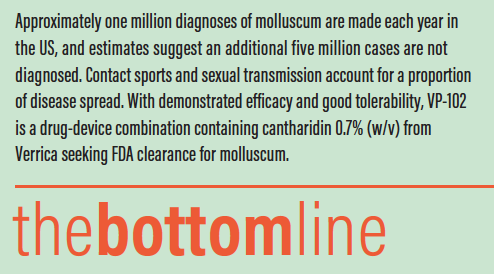Molluscum contagiosum has impacted patients and challenged dermatologists for years. Generally considered benign and painless, they can be bothersome when they occur in a cosmetically sensitive area or for certain patient populations. In patients with atopic dermatitis, they can spread quickly, especially if scratched or picked, and are at high risk to become inflamed and possibly infected. For some individuals, such as certain competitive athletes, the presence of molluscum can lead to a disruption in activities. Approximately one million diagnoses of molluscum are made each year in the US, and estimates suggest an additional five million cases are not diagnosed. A few recent developments, including therapeutic advancements, have focused attention on these disease issues, their incidence, and their impact.

Molluscum Overview and Trends
Molluscum papules tend to appear in clusters of individuals who have frequent close physical contact and is among the most commonly diagnosed skin conditions in athletes participating in contact sports.1 Cutaneous infections, including molluscum, are responsible for up to 20 percent of lost training and competition time in all contact sports and are the second leading cause (following upper respiratory infections) of all medical consultations among young wrestlers.2 In fact, the term “molluscum gladiatorum” has been proposed to describe molluscum that occur in wrestlers.3 As martial arts gain popularity among all age groups, there is more spread seen in this group of participants as well.4
Sexual transmission of molluscum is also common, and many dermatologists report seeing an increase in transmission among older adults. The CDC estimates that one in five American adults has an STD, although their reporting on molluscum specifically is limited, as it is often not included in this class of diseases. Incidence rates for chlamydia, gonorrhea, and syphilis are all on the increase in the US, according to the latest data. And many speculate that expansion of COVID-19 vaccines and the lifting of social distancing restrictions could lead to a burst in sexual activity and subsequent increase in STDs.
Sexually Transmitted Infections (STIs) remain most common in younger adults. Although 14- to 24-year-olds represent about 25 percent of the sexually active population, they account for half of new cases of STIs each year.5 Of note, rates of STIs have been increasing year-over-year for individuals age 55 to 64 as well those 65 and older. For example, the rate of chlamydia among those 65+ stood at 4.6 per 100,000 in 2018, compared to 3.1 per 100,000 in 2014. Dermatologists should be attentive to the risk for STIs, including molluscum, across all age groups.
Diagnosis
The diagnosis of molluscum in most cases is clinically straightforward—small (2–5mm in diameter), waxy, skin-colored papules with an umbilicated appearance. However, atypical forms are possible, especially in older adults and/or those with immunosuppression.5
Dermoscopy can be used to assist diagnosis. Rarely, biopsy is performed to confirm the diagnosis.
In addition to diagnosis and treatment, discussed below, patients require education on reduction of risk for autoinoculation and spread of disease. Many parents of pediatric patients who are diagnosed with molluscum worry about pain and scarring but overlook contagion. Patients who excoriate papules can release a significant viral load that can produce new infections at other exposed body sites. Those individuals with molluscum who come in skin-to-skin contact with others should cover existing lesions to reduce risk of spread. Current return to play guidance for athletes in contact sports recommends curettage and covering of molluscum lesions.6 Risk of spread via fomites on clothing, towels, and equipment should also be discussed with patients.
Treatment Overview
Cryotherapy and curettage are probably the most common interventions for molluscum, although both risk blistering, scarring, and post-inflammatory hypo- or hyperpigmentation. Pulsed dye laser treatment can be effective, though its use is limited by costs and availability. Potassium hydroxide shows somewhat less efficacy than physician-directed approaches but may be a worthwhile, patient-directed option.7 Other topical interventions show modest if any effects, according to a recent Cochrane review. Notably, that analysis found topical imiquimod no more effective than vehicle for molluscum, but it was associated with many more local skin reactions.8
Given the limitations of existing interventions, some physicians and patients have been hesitant to initiate treatment of molluscum, but the emergence of an effective, well-tolerated intervention specifically for molluscum promises to change the course of care.
Cantharidin had been used for the management of molluscum for some time but access to this agent from dispensing pharmacies has become restricted. Additionally, there was some variability in potency and efficacy across suppliers.
Cantharidin is a vesicant. Cantharidin instigates release of serine proteases by epidermal cells. These proteases cause the breakdown of the desmosomal plaque, loss of intracellular attachments, and formation of intraepidermal blisters.9 Historically, use of cotton swabs and other non-specific applicators to administer cantharidin has led to placement of drug beyond the intended papules, leading in some instances to robust blistering and discomfort. Of note, since the action of cantharidin is largely restricted to the epidermis with no involvement of the basal layer, risk for scarring is minimal.10
A novel drug/device combination may provide a solution to the challenge of providing consistent delivery without unnecessary skin irritation. VP-102 is a drug-device combination containing cantharidin 0.7% (w/v) currently under FDA review with the conditionally accepted trade name of YCanth (Verrica Pharmaceuticals). The single-use applicator is designed to facilitate precise application of active drug to molluscum papules to avoid blistering of uninvolved skin.
In two Phase 3, vehicle-controlled trials (CAMP-1 and CAMP-2) in adults and children, VP-102 demonstrated superior efficacy to vehicle in the percentage of participants with complete clearance of molluscum lesions at day 84. The most common adverse events included application site vesicles, pain, pruritus, erythema, and scab. Most adverse events were mild or moderate in severity.11 The single-use applicator for PV-102 allows for precise topical dosing and targeted administration. The agent is also under investigation for warts.
Phase 2 trial data show similar efficacy—a 90 percent reduction in lesions from baseline, approximately half of subject (48.5 percent) had complete lesion clearance—and demonstrated negligible systemic exposure of cantharidin with topical application.
In clinical trials for VP-102, cantharidin was applied to lesions every 21 days for up to four treatments.
A Molluscum First
Although molluscum will eventually spontaneously resolve in healthy patients (there is variability in the reported persistence of lesions up to 18 months), the fact is that patients can expect untreated papules to be present for months, rather than weeks. Untreated papules can cause uncomfortable itch, may become infected, and create a reservoir to spread disease to other body sites or to other individuals. The emergence of a proprietary drug/device combination for the effective and consistent delivery of cantharidin to treat molluscum represents an important development for patients and the doctors who treat them. YCanth is the first drug to seek FDA approval for molluscum contagiosum. It demonstrates significant efficacy and good tolerability in both pediatric and adult patients.
1. Peterson AR, Nash E, Anderson BJ. Infectious Disease in Contact Sports. Sports Health. 2019 Jan/Feb;11(1):47-58.
2. Nowicka D, Bagłaj-Oleszczuk M, Maj J. Infectious diseases of the skin in contact sports. Adv Clin Exp Med. 2020 Dec;29(12):1491-1495.
3. Thompson AJ, Matinpour K, Hardin J, Hsu S. Molluscum gladiatorum. Dermatol Online J. 2014 Jun 15;20(6):13030
4. Lee SK. Molluscum contagiosum infection in mixed martial arts fighting: molluscum gladiatorum. J Cutan Med Surg. 2013 May-Jun;17(3):151-2.
5. Murphy M, Chedister GR, George V. Non-HPV Perianal and Anorectal Sexually Transmitted Viral Infections. Clin Colon Rectal Surg. 2019 Sep;32(5):340-346.
6. Zinder SM, Basler RS, Foley J, Scarlata C, Vasily DB. National athletic trainers’ association position statement: skin diseases. J Athl Train. 2010 Jul-Aug;45(4):411-28.
7. Meza-Romero R, Navarrete-Dechent C, Downey C. Molluscum contagiosum: an update and review of new perspectives in etiology, diagnosis, and treatment. Clin Cosmet Investig Dermatol. 2019 May 30;12:373-381.
8. van der Wouden JC, van der Sande R, Kruithof EJ, Sollie A, van Suijlekom-Smit LW, Koning S. Interventions for cutaneous molluscum contagiosum. Cochrane Database Syst Rev. 2017 May 17;5(5):CD004767.
9. Ogilvie-Turner K, Goldman RD. Cantharidin for molluscum contagiosum. Can Fam Physician. 2020 Jun;66(6):419-420.
10. Del Rosso JQ, Kircik L. Topical Cantharidin in the Management of Molluscum Contagiosum: Preliminary Assessment of an Ether-free, Pharmaceutical-grade Formulation. J Clin Aesthet Dermatol. 2019;12(2):27-30.
11. Eichenfield LF, McFalda W, Brabec B, Siegfried E, Kwong P, McBride M, Rieger J, Willson C, Davidson M, Burnett P. Safety and Efficacy of VP-102, a Proprietary, Drug-Device Combination Product Containing Cantharidin, 0.7% (w/v), in Children and Adults With Molluscum Contagiosum: Two Phase 3 Randomized Clinical Trials. JAMA Dermatol. 2020 Dec 1;156(12):1315-1323.








